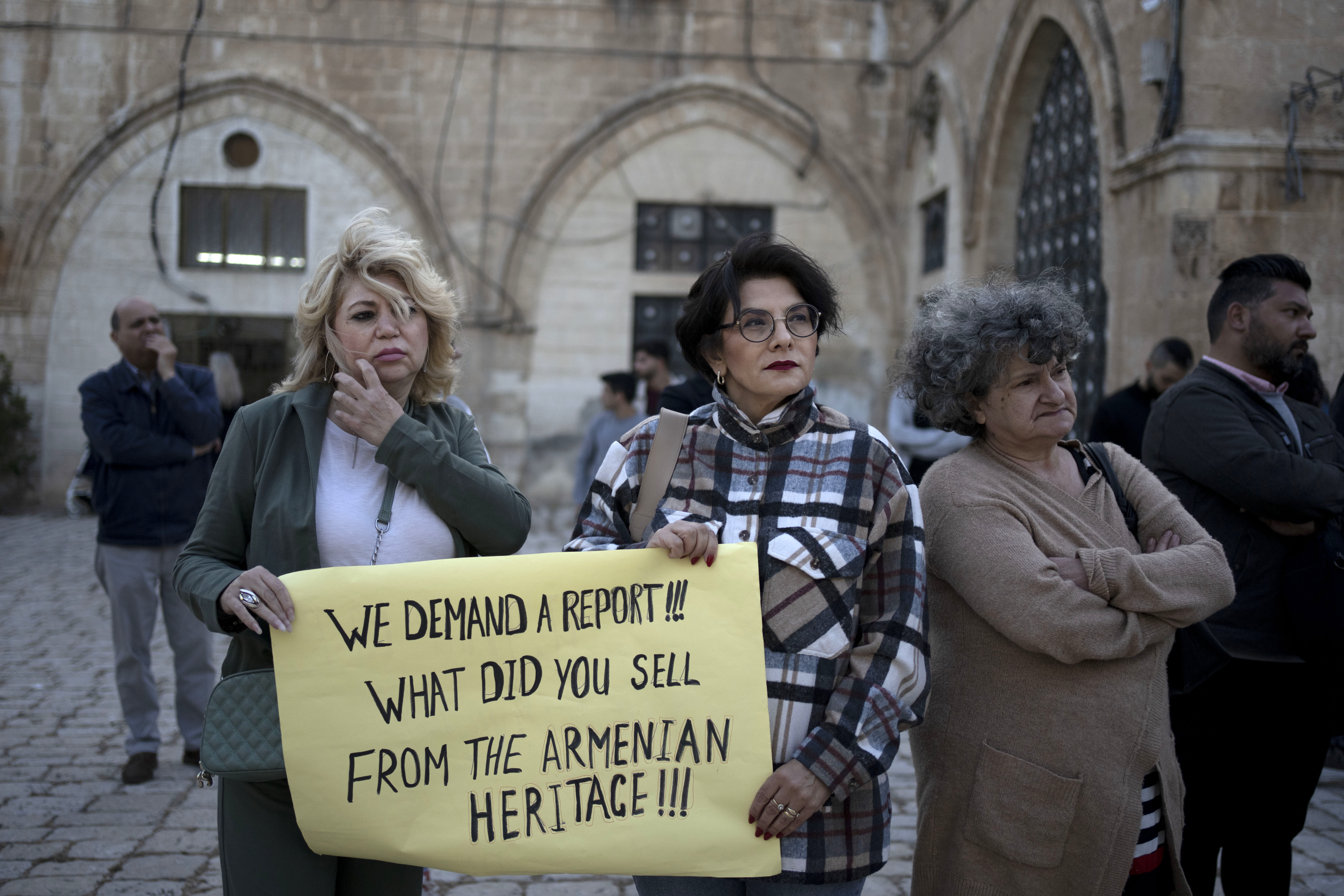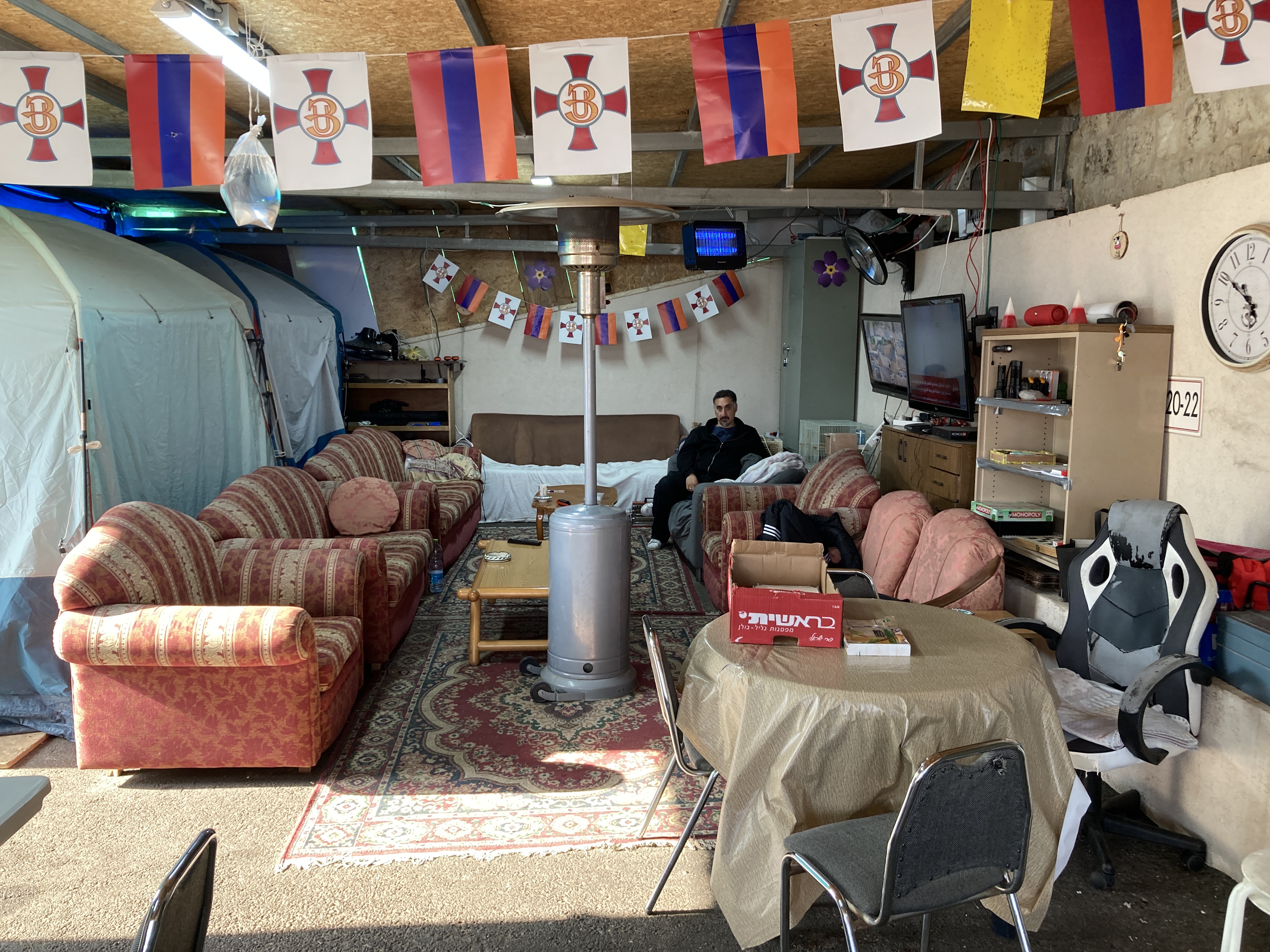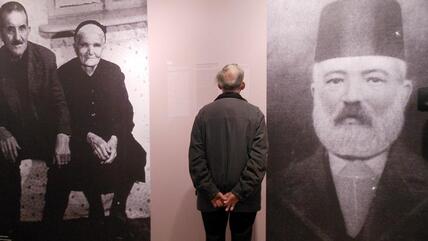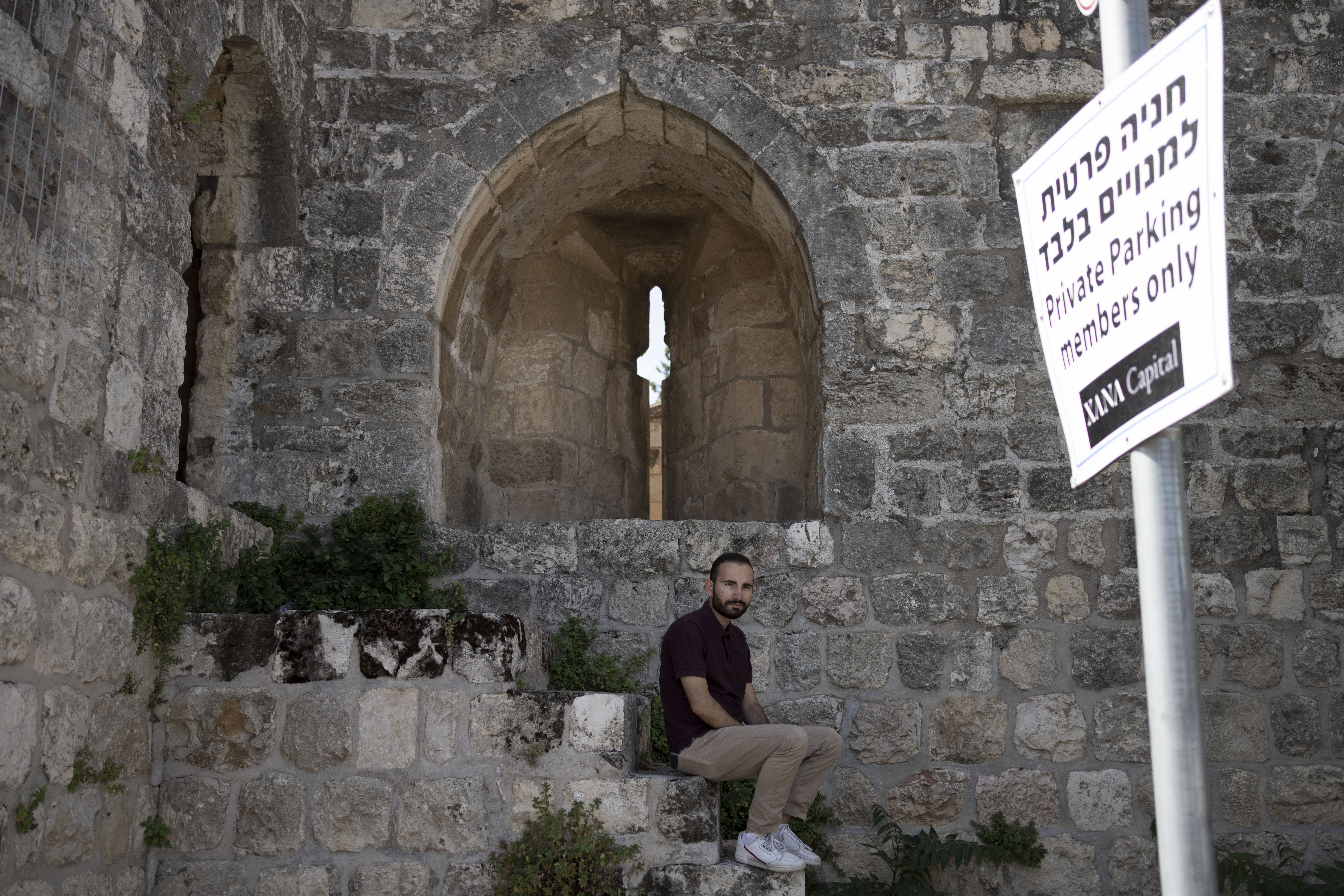"An existential struggle in defence of our heritage"

Jerusalem’s Armenian quarter is in the otherwise quiet southwestern corner of the Old City. Within sight of the monastery and the Cathedral of St. James is the shell of a building constructed from pressed boards, with sofas and carpets, a makeshift kitchen, a water supply and heaters. For more than eight months, young Armenians, mostly men, have been keeping watch at the sight day and night. “Protect the heritage of our ancestors!” and other slogans cover the walls, alongside a historical map of the routes taken by Armenians fleeing genocide in the Ottoman Empire in 1915-16, one of which led to Jerusalem. Outside surveillance cameras are pointing in all directions, so that residents can be warned in time if gangs of aggressive settlers return.
“The settlers want to Judaize the old town,” is how Hagop Djernazian, spokesman for the camp, sums up the situation. The self-confident 24-year-old is studying International Relations at the Hebrew University and speaks Armenian, Arabic, Hebrew and English. Djernazian and his campmates see themselves in a double battle: against Jewish hooligans causing trouble in the neighbourhood, in some cases even spitting at priests, and against the compliance of the Armenian Patriarchate, which since 2021 secretly planned to sell valuable land in the neighbourhood to a Jewish investor.
A church thriller, the struggle revolves around the Cow Garden, a patch of asphalt where monks used to keep cows for their milk, as well as a seminary and living quarters. It’s now a prime piece of land for a hotel or luxury apartments operated by companies with close ties to settlers. When the secret deal became public knowledge, the local community rose up in revolt. The Armenian Patriarchate quickly terminated the contract, and the matter has now gone to court. There the locals have mounted their own legal case – according to the community’s constitution, the Patriarchate is not entitled to give church property away to outsiders.
The rift between the grassroots level and the Patriarchate, which acts as a civil authority, has a unique dimension: the clergy generally come from outside, from theological colleges. Generating income is more important to them than local patriotism. One priest who was removed from office as a scapegoat, had to flee to the USA.

Who does the old city of Jerusalem belong to?
Armenians have lived in Jerusalem since the fourth century, when the first pilgrims came to visit the holy sites of Christianity. At times, the Patriarchate was the supreme authority for Armenians from Cyprus to Egypt. Today, the Armenian population in the old town barely numbers 2,000 people, but the conflict here has significance beyond the local community. The greed of settler groups and companies for real estate in the Old City has already caused problems for other communities. In the Greek Orthodox Church, a Patriarch was even forced to resign over the issue, but the community couldn't stop the loss of property.
This is another reason Armenians are now mobilizing with so much energy: the battle in court could take years, while “sovereignty and dignity” are being defended on the streets. The Save the Armenian Quarter committee was founded in 2023 after one demonstration and is generating solidarity, sympathy, and funds via social media. The protest camp and the permanent vigil were set up in November 2023, after armed settlers appeared at the site with a bulldozer; refusing to accept that the property dispute would now be settled in court, they tried to use violence to change the facts.
The Israeli police did not arrest the culprits, but instead, a group of Armenians who were protecting the church property. Since that day, barricades have marked the boundaries of the protected area. With the rubble left behind after the confrontation, activists built a small symbolic Mount Ararat bearing an Armenian flag.

Turning a blind eye
On 24 April, people all over the world will commemorate the mass killing of Armenians 100 years ago. A memorial service is planned in Germany as well. Many critics contend, however, that the country should take a closer look at the role played by the German Empire, which was an ally of the Ottoman Empire at the time of the massacres. By Ceyda Nurtsch
‘Jerusalem is my identity’
Armenians in the camp are divided on the question of whether they see themselves as Palestinian. “No,” says Hagop Djernazian. “I am a Jerusalemite; Jerusalem is my identity. Full stop.” His colleague Sertrag Balian, a graceful figure who wears his long hair tied back, sees himself differently: he is Armenian Palestinian.
The name Balian is synonymous with Jerusalem's most famous ceramics studio. Sertrag's ancestors arrived as genocide survivors and brought their artisanry with them, later fusing Anatolian design with Levantine motifs to create the treasured Jerusalem ceramics. Sertrag Balian is the fourth generation to continue the trade. You can watch him leading a ceramics workshop in the morning, and in the afternoon he hosts a live webinar from his balcony on Instagram for young Armenians in France about “the fight against police, settlers, religious extremists and colonisers.” Balian delivers the talk in French, his fifth language.
The fact that he sees himself as a Palestinian is not just a political statement, it also reflects a historical perspective. Before the arrival of British colonisers, who liked to draw lines between ethnicities and religions, the Armenians in the Ottoman Empire saw themselves as part of Arab-Palestinian society, writes US Armenian historian Bedross Der Matossian, a native of Jerusalem. Arabic was the first language of the Armenians at that time. They worked as barbers, shoemakers, and tailors. After 1915, the influx of refugees changed the face of the community: the long-established Armenians became a minority compared to the Turkish-speaking newcomers.

The exodus after the exodus
An Armenian modernity emerged in Jerusalem in the 1930s when a wealthy middle class outside the Old City began to share neighbourhoods with Muslims and Christians of other denominations, united by their similar lifestyles. This period of prosperity ended abruptly with the founding of the Israeli state in 1948 and the subsequent Arab-Israeli war. As the Palestinian upper class in West Jerusalem was driven out of the Talbiya and Qatamon neighbourhoods, their Armenian neighbours also lost their homes and businesses. Thousands left the country. A generation after the genocide, they had once again become refugees.
These historical traumas shape the worldview of today's young generation. Their language is both activistic and solemn, full of pride in their long spiritual tradition in Jerusalem but underpinned by a sense of vulnerability. "This is an existential struggle in defence of our heritage," says Hagop Djernazian.
For the Palestinian population, the Armenian genocide is an indisputable historical fact, but Israel does not officially recognise it. The term genocide is reserved for the Holocaust. You can imagine what it means for Armenians when they hear settler hooligans shouting today: "You don't belong here, you have no right to live here. When the Messiah comes, we will kill you all."
State-promoted hatred of all things non-Jewish
The Old City is part of occupied East Jerusalem, which was annexed by Israel in 1980 - a move that in the rest of the world has never been recognised as legal. Recently, the International Court of Justice also ruled that the entire occupation is illegal under international law. The Old City is therefore a doubly illegal area. Radical settlers are not bothered by this, on the contrary: the right-wing nationalist course set by the Netanyahu government encourages the so-called Hilltop Youth from the settlements to live out their hatred of everything non-Jewish.
The battle cry of "burn it down" was initially intended for villages in the West Bank but can now be heard in the Old City too. Jewish hooligans shouted "may it burn down" during the July attack on the Armenian Tavern, a long-established restaurant near the convent, just a few metres from a police station. Hoodies pulled over sidelocks, the intruders sprayed pepper spray and smashed furniture. They came twice in one week; that is how safe they felt.
This type of violence is new in the Old City, says Jewish Jerusalem expert Daniel Seidemann. As a lawyer and private citizen, he is passionately trying to defend the city's diversity against Zionist claims to power. “Attempting to physically intimidate an entire community is beyond anything we have witnessed before.”
Like other representatives of Jewish and Palestinian civil society, Seidemann has come to a solidarity dinner on the grounds of the protest camp. The gathering in the evening light is fuelled by a conviction that the Armenian struggle concerns them all. “Let's stand together,” says Hagop Djernazian, “for a humane, multicultural Jerusalem.”
© Qantara.de 2024
The journalist and author Charlotte Wiedemann primarily focuses on societies outside Europe and their conflicts with the West. Her most recent publication in German is "Den Schmerz der Anderen begreifen: Holocaust and World Memory".
